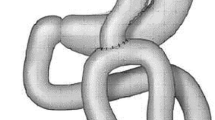Abstract
Background
Gastric bypass surgery is an effective and long-lasting treatment of morbidly obese patients. However, the bypass limb may need to be tailored in morbidly obese patients with a wide range of obesity. The aim of the present study was to report clinical result of tailored bypass limb in a group of patients receiving laparoscopic mini-gastric bypass surgery.
Methods
From Jan 2002 to Dec 2006, laparoscopic mini-gastric bypass was performed in 644 patients [469 women, 175 men: mean age 30.5 ± 8.1 years; mean body mass index (BMI) 43.1 ± 6.0] in our department. The gastric bypass limb was tailored according to the preoperative BMI. The clinical data and outcomes were analyzed. All the clinical data were prospectively collected and stored.
Results
Two hundred eighty-six patients belonged to lower BMI (BMI < 40; mean 36.0), 286 patients moderate BMI (BMI 40–50; mean 43.2), and 72 patients higher BMI (BMI > 50; mean 55.4). All procedures were completed laparoscopically. Mean operative time was 130 min, and mean hospital stay was 5.0 days. Twenty-three minor early complications (4.3%) and 13 major complications (2.0%) were encountered, with one death occurred (0.016%). There was no significant difference in operation time and complication rate between the groups. The mean bypass limb was 150 cm for the lower BMI group, 250 cm for moderate BMI group, and 350 cm for the higher BMI group. The mean BMI reduction 2 years after surgery was 10.7, 15.5, and 23.3 for the lower, moderate, and higher BMI group. The weight loss curves and resolution of obesity related comorbidities were compatible with the tailored bypass limbs between the groups. However, the lower BMI patients had more severe anemia than the other two groups.
Conclusion
Morbidly obese patients receiving gastric bypass surgery may need to tailor the bypass limb according to BMI. The application of gastric bypass in lower BMI patients should be more carefully.


Similar content being viewed by others
References
Dietel M. Overview of operations for morbid obesity. World J Surg 1998;22:913–8.
Lee WJ, Wang W. Bariatric surgery: Asia-pacific perspective. Obes Surg 2005;15:751–7.
Sjostrom L, Lindroos AK, Peltonen M, et al. Lifestyle, diabetes, and cardiovascular risk factors 10 years after bariatric surgery. N Engl J Med 2004;351:2683–93.
O’Brien PE, Dixon JB, Laurie, et al. Treatment of mild to moderate obesity with laparoscopic adjustable gastric banding or an intensive medical program. Ann Intern Med 2006;144:625–33.
Buchwald H, Avidor Y, Brauwald E, Jensen MD, Pories W, Fahrbach K, et al. Bariatric surgery: a systematic review and meta-analysis. JAMA 2004;292:1724–37.
Rubino F, Gagner M, Gentileschi P, et al. The early effect of the Roux-en-Y gastric bypass on hormones involved in body weight regulation and glucose metabolism. Ann Surg 2004;240:236–42.
Wittgrove A, Clark G. Laparoscopic gastric bypass, Roux-en-Y: 500 patients: technique and results, with 3–60 month follow-up. Obes Surg 2000;10:233–9.
Schauer P, Ikramuddin S, Gouash W, et al. Outcomes after laparoscopic gastric bypass for morbid obesity. Ann Surg 2000;232:515–29.
Lee WJ, Yu PJ, Wang W, Chen TC, Wei PL, Huang MT. Laparoscopic Roux-en-Y versus mini-gastric bypass for the treatment of morbid obesity. Ann Surg 2005;242:20–8.
Wang HH, Wei PL, Lee YC, Huang MT, Chiu CC, Lee WJ. Short-term results of laparoscopic mini-gastric bypass. Obes Surg 2005;15:648–54.
Higa K, Boone K, Ho T, et al. Laparoscopic Roux-en-Y gastric bypass for morbid obesity. Arch Surg 2000;135:1029–34.
DeMaria EJ, Sugerman HJ, Kellum JM, et al. Results of 281 consecutive total laparoscopic Roux-en-Y gastric bypasses to treat morbid obesity. Ann Surg 2002;235:640–7.
Flum DR, Salem L, Elrod JAB, et al. Early mortality among Medicare beneficiaries undergoing bariatric surgical procedures. JAMA 2005;294:1903–8.
Rutledge R. The mini-gastric bypass: experience with the first 1,274 cases. Obese Surg 2001;11:270–80.
Rutledge R, Walsh T. Continued excellent results with the mini-gastric bypass: six-year study in 2,410 patients. Obes Surg 2005;15:1304–8.
Brolin RE, Kencer HA, Gorman JH, et al. Long-limb gastric bypass in the superobese: a prospective randomized study. Ann Surg 1992;215:387–95.
Sugerman H, Kellum JM, Demaria EJ. Conversion of proximal to distal gastric bypass for failed gastric bypass for superobesity. J Gastrointest Surg 1997;1:517–25.
Choban PS, Flancbaum L. The effect of Roux limb lengths on outcome after Roux-en-Y gastric bypass: a prospective, randomized clinical trial. Obes Surg 2002;12:540–5.
Leifsson BG, Gislason HG. Laparoscopic Roux-en-Y gastric bypass with 2-meter long biliopancreatic limb for morbid obesity: Technique and experience with the first 150 patients. Obes Surg 2005;15:35–42.
Helling TS. Operative experience and follow-up in a cohort of patients with a BMI > 70 kg/m2. Obes Surg 2005;15:482–5.
Han SM, Kim WW, Oh JH. Results of laparoscopic sleeve gastrectomy (LSG) at 1 year in morbidly obese Korean patients. Obes Surg 2005;15:1469–75.
Chen HH, Lee WJ, Wang W et al. Greater weight loss in morbidly obese patients undergoing gastric banding with Ala55Val polymorphism on UCP 2 gene. Obes Surg 2007;17(7): 926–33.
Acknowledgments
This work was supported by grant MGH 95-A-001 from Min-Sheng General Hospital.
Author information
Authors and Affiliations
Corresponding author
Rights and permissions
About this article
Cite this article
Lee, WJ., Wang, W., Lee, YC. et al. Laparoscopic Mini-gastric Bypass: Experience with Tailored Bypass Limb According to Body Weight. OBES SURG 18, 294–299 (2008). https://doi.org/10.1007/s11695-007-9367-9
Received:
Accepted:
Published:
Issue Date:
DOI: https://doi.org/10.1007/s11695-007-9367-9




